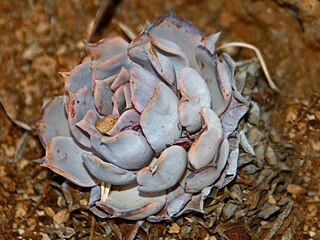
Echeveria is a large genus of flowering plants in the family Crassulaceae, native to semi-desert areas of Central America, Mexico and northwestern South America.

Dudleya candelabrum is a species of succulent plant known by the common names candleholder liveforever or candleholder dudleya. Endemic to California, this species grows wild only on the northern Channel Islands, where it is found in open rocky places and north-facing slopes. It is characterized by thin, spade-shaped green leaves and an inflorescence covered in long, reflexed bracts, with pale yellow flowers. It has been threatened by poachers shipping plants to South Korea.

Dudleya farinosa is a species of succulent plant in the family Crassulaceae known by several common names, including bluff lettuce, powdery liveforever, and powdery dudleya. A coastal plant of northern California and southern Oregon, it is typically found on ocean bluffs just directly above the reach of the waves, and sometimes inland. Its appearance is characterized by lotus-like rosettes of beveled leaves, and in summer the plant erects a tall pink to red peduncle densely covered in bracts, topped with branches of pale yellow flowers. The green or white rosettes of this plant can be seen covering stretches of rocky coast and nearby islets.

Echeveria setosa, the Mexican fire cracker, is a species of flowering plant in the family Crassulaceae, native to semi-desert areas of Mexico and common throughout Puebla.

Cyclamen coum, the eastern sowbread, is a species of flowering plant in the family Primulaceae. It is a tuberous herbaceous perennial, growing to 5–8 cm (2–3 in), with rounded heart-shaped leaves and pink shell-shaped flowers with darker coloration at the base. It is valued in horticulture as groundcover, and for the flowers which bloom in winter and early spring.

Zinnia elegans known as youth-and-age, common zinnia or elegant zinnia, is an annual flowering plant in the family Asteraceae. It is native to Mexico but grown as an ornamental in many places and naturalised in several places, including scattered locations in South and Central America, the West Indies, the United States, Australia, and Italy.

Echeveria agavoides, or lipstick echeveria, is a species of flowering plant in the family Crassulaceae, native to rocky areas of Mexico, notably the states of San Luis Potosí, Hidalgo, Guanajuato and Durango.

Echeveria lilacina, common name ghost echeveria or Mexican hens and chicks, is a species of succulent plants in the genus Echeveria belonging to the family Crassulaceae.

Echeveria runyonii is a species of flowering plant in the family Crassulaceae, that is native to the state of Tamaulipas in Mexico. Several cultivars have been described and cultivated.

Echeveria derenbergii, the painted-lady, is a species of flowering plant in the family Crassulaceae, endemic to Mexico.

Echeveria strictiflora, the desert savior, is a species of flowering plant in the family Crassulaceae, native to southwestern Texas and to the Chihuahuan Desert of northeast Mexico. Its range consists of several scattered populations, rather than a contiguous range.

Echeveria multicaulis is a species of plant native to Mexico. It is a member of the genus Echeveria.

Echeveria atropurpurea is a species of succulent plant in the Crassulaceae family. It is a perennial commonly known as chapetona or siempreviva, and is a endemic to Central Veracruz, Mexico in tropical deciduous forests. It is noted for its fast growing, easy cultivation, and red to yellow flowers. It is currently threatened by habitat loss.

Echeveria minima, the miniature echeveria, is a species of flowering plant in the family Crassulaceae, native to northeast Mexico. It has small, blue-green rosettes with pink edges growing in clusters, and produces yellow bell-shaped flowers in the spring. A succulent, it has gained the Royal Horticultural Society's Award of Garden Merit.

Echeveria pulvinata, the plush plant, is a species of flowering plant in the genus Echeveria, native to southwest and central Mexico. A succulent, it has gained the Royal Horticultural Society's Award of Garden Merit. Its variety Echeveria pulvinata var. leucotricha, under the synonym Echeveria leucotricha, the chenille plant, has also gained the Award of Garden Merit.

Echeveria secunda, called the glaucous echeveria, is a species of succulent flowering plant in the genus Echeveria, native to Mexico, and introduced to the Dominican Republic, New Zealand, and Vietnam. Its cultivar 'Compton Carousel' has gained the Royal Horticultural Society's Award of Garden Merit.

Echeveria shaviana, called Mexican hens or Mexican hens and chicks, is a species of flowering plant in the family Crassulaceae, native to northeastern Mexico. A succulent, it has gained the Royal Horticultural Society's Award of Garden Merit.

Echeveria rosea is a species of flowering plant in the family Crassulaceae, native to Mexico. A succulent, it has gained the Royal Horticultural Society's Award of Garden Merit.

Echeveria cante, the white cloud plant, is a species of flowering plant in the family Crassulaceae, native to northwestern Zacatecas state in Mexico. A succulent, it has gained the Royal Horticultural Society's Award of Garden Merit.

Dudleya saxosa subsp. collomiae, known by the common name Gila County liveforever, is a subspecies of perennial succulent plant within the genus Dudleya native to central Arizona. It is characterized by showy bright-yellow flowers on an upright inflorescence colored pink, red or orange. The leaves are green or covered in a white, powdery wax. This species is found growing in rocky slopes, canyons, and crevices, and often on Sonoran Desert sky islands.





















